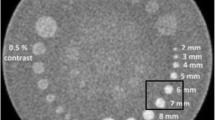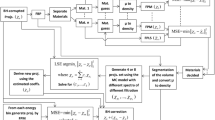Abstract
Cone-beam computed tomography (CBCT) is an important imaging modality for image-guided radiotherapy and adaptive radiotherapy. Feldkamp–Davis–Kress (FDK) method is widely adopted in clinical CBCT reconstructions due to its fast and robust application. While iterative algorithms have been shown to outperform FDK techniques in reducing noise and imaging dose, they are unable to correct projection-domain artefacts such as beam hardening and scatter. Empirical correction techniques require a holistic approach as beam hardening and scatter coexist in the measurement data. This multi-part proof of concept study conducted in MATLAB presents a novel approach to artefact reduction for CBCT image reconstruction. Firstly, we decoupled the beam hardening and scatter contributions originating from the imaging object and the bowtie filter. Next, a model was constructed to apply pixel-wise corrections to separately account for artefacts induced by the imaging object and the bowtie filter, in order to produce mono-energetic equivalent and scatter-compensated projections. Finally, the effectiveness of the correction model was tested on an offset phantom scan as well as a clinical brain scan. A conjugate-gradient least-squares algorithm was implemented over five iterations using FDK result as the initial input. Our proposed correction model was shown to effectively reduce cupping and shading artefacts in both phantom and clinical studies. This simple yet effective correction model could be readily implemented by physicists seeking to explore the benefits of iterative reconstruction.






Similar content being viewed by others
References
Beister M, Kolditz D, Kalender WA (2012) Iterative reconstruction methods in X-ray CT. Phys Med 28(2):94–108
Löve A, Olsson M-L, Siemund R, Stålhammar F, Björkman-Burtscher IM, Söderberg M (2013) Six iterative reconstruction algorithms in brain CT: a phantom study on image quality at different radiation dose levels. Br J Radiol. https://doi.org/10.1259/bjr.20130388
Shieh CC, Gonzalez Y, Li B et al (2019) SPARE: Sparse-view reconstruction challenge for 4D cone-beam CT from a 1-min scan. Med Phys 46(9):3799–3811
Biguri A, Soleimani M, Dosanjh M, Hancock S (2016) TIGRE: A MATLAB-GPU toolbox for CBCT image reconstruction. Biomed Phys Eng Express. https://doi.org/10.1088/2057-1976/2/5/055010
Rit S, Vila Oliva M, Brousmiche S, Labarbe R, Sarrut D, Sharp GC (2014) The reconstruction toolkit (RTK), an open-source cone-beam CT reconstruction toolkit based on the insight toolkit (ITK). J Phys Conf Ser. https://doi.org/10.1088/1742-6596/489/1/012079
van Aarle W, Jan Palenstijn W, De Beenhouwer J, Altantzis T, Bals S, Batenburg KJ, Sijbers J (2015) The ASTRA toolbox: a platform for advanced algorithm development in electron tomography. Ultramicroscopy 157:35–47
Siewerdsen JH, Moseley DJ, Bakhtiar B, Richard S, Jaffray DA (2004) The influence of antiscatter grids on soft-tissue detectability in cone-beam computed tomography with flat-panel detectors. Med Phys 31(12):3506–3520
Poludniowski G, Evans PM, Hansen VN, Webb S (2009) An efficient Monte Carlo-based algorithm for scatter correction in keV cone-beam CT. Phys Med Biol 54(12):3847–3864
Sun M, Star-Lack JM (2010) Improved scatter correction using adaptive scatter kernel superposition. Phys Med Biol 55(22):6695–6720
Wang A, Maslowski A, Messmer P et al (2018) Acuros CTS: A fast, linear Boltzmann transport equation solver for computed tomography scatter—Part II: system modelling, scatter correction, and optimization. Med Phys 45(5):1914–1925
Benítez RB, Ning R (2010) Development of a beam hardening filter and characterization of the spatial resolution for a Cone Beam CT imaging system. Proc SPIE Int Soc Opt Eng 7622:762237
Coleman AJ, Sinclair M (1985) A beam-hardening correction using dual-energy computed tomography. Phys Med Biol. https://doi.org/10.1088/0031-9155/30/11/007
Meagher JM, Mote CD, Skinner HB (1990) CT image correction for beam hardening using simulated projection data. IEEE Trans Nucl Sci. https://doi.org/10.1109/23.55865
Mail N, Moseley DJ, Siewerdsen JH, Jaffray DA (2009) The influence of bowtie filtration on cone-beam CT image quality. Med Phys 36(1):22–32
Zhang G, Marshall N, Jacobs R, Liu Q, Bosmans H (2013) Bowtie filtration for dedicated cone beam CT of the head and neck: a simulation study. Br JRadiol. https://doi.org/10.1259/bjr.20130002
Kontson K, Jennings RJ (2015) Bowtie filters for dedicated breast CT: theory and computational implementation. Med Phys 42(3):1453–1462
Blessing M, Bhagwat MS, Lyatskaya Y, Bellon JR, Hesser J, Zygmanski P (2012) Kilovoltage beam model for flat panel imaging system with bow-tie filter for scatter prediction and correction. Phys Med 28(2):134–143
Zhao W, Brunner S, Niu K, Schafer S, Royalty K, Chen G (2015) Patient-specific scatter correction for flat-panel detector-based cone-beam CT imaging. Phys Med Biol 60:1339–1365
Dremel K, Fuchs T, Firsching M, Hanke R (2018) Beam hardening correction in X-ray computed tomography: a comparison of two iterative model-based reconstruction methods. Paper presented at: 11th European Conference on Non-Destructive Testing; October 6–10, 2014; Prague. http:// https://www.ndt.net/events/ECNDT2014/app/content/Paper/576_Dremel_Rev1.pdf. Accessed September 20, 2018
Abdoli M, Mehranian A, Ailianou A, Becker M, Zaidi H (2016) Assessment of metal artifact reduction methods in pelvic CT. Med Phys 43(4):1588–1597
Meyer E, Raupach R, Lell M, Schmidt B, Kachelriess M (2010) Normalized metal artifact reduction (NMAR) in computed tomography. Med Phys 37(10):5482–5493
Meyer E, Raupach R, Lell M, Schmidt B, Kachelriess M (2012) Frequency split metal artifact reduction (FSMAR) in computed tomography. Med Phys 39(4):1904–1916
Giles W, Bowsher J, Hao L, Yin F-F (2011) Crescent artifacts in cone-beam. Med Phys 38(4):2116–2121
Braun H, Kyriakou Y, Kachelrieß M, Kalender WA (2010) The influence of the heel effect in cone-beam computed tomography: artifacts in standard and novel geometries and their correction. Phy Med Biol 55:6005–6021
Bootsma GJ, Verhaegen F, Jaffray DA (2011) The effects of compensator and imaging geometry on the distribution of x-ray scatter in CBCT. Med Phys 38(2):897–914
Author information
Authors and Affiliations
Corresponding author
Ethics declarations
Conflicts of interest
The authors declare that they have no conflict of interest.
Additional information
Publisher's Note
Springer Nature remains neutral with regard to jurisdictional claims in published maps and institutional affiliations.
Rights and permissions
About this article
Cite this article
Cai, M., Byrne, M., Archibald-Heeren, B. et al. Decoupling of bowtie and object effects for beam hardening and scatter artefact reduction in iterative cone-beam CT. Phys Eng Sci Med 43, 1161–1170 (2020). https://doi.org/10.1007/s13246-020-00918-8
Received:
Accepted:
Published:
Issue Date:
DOI: https://doi.org/10.1007/s13246-020-00918-8




